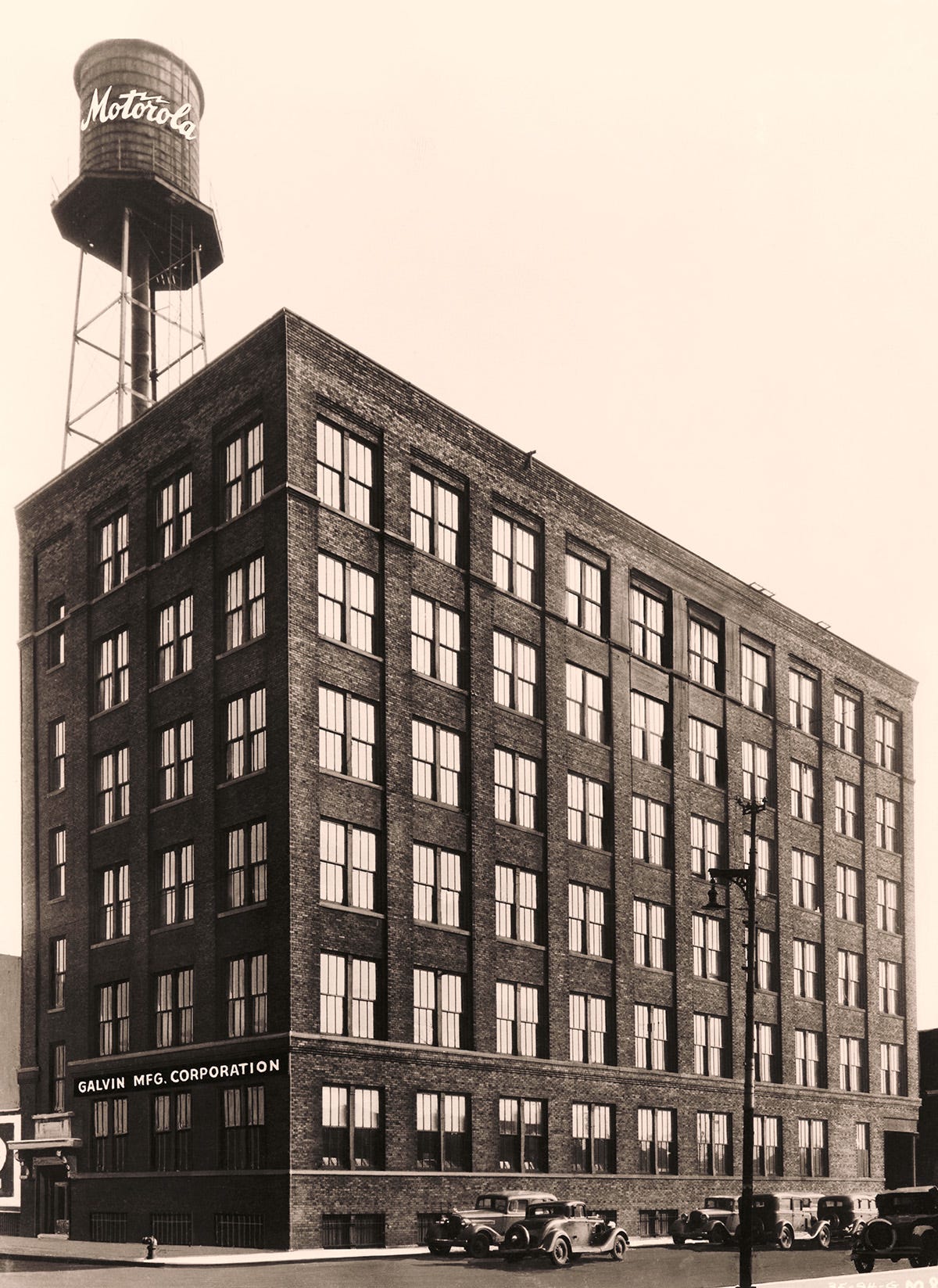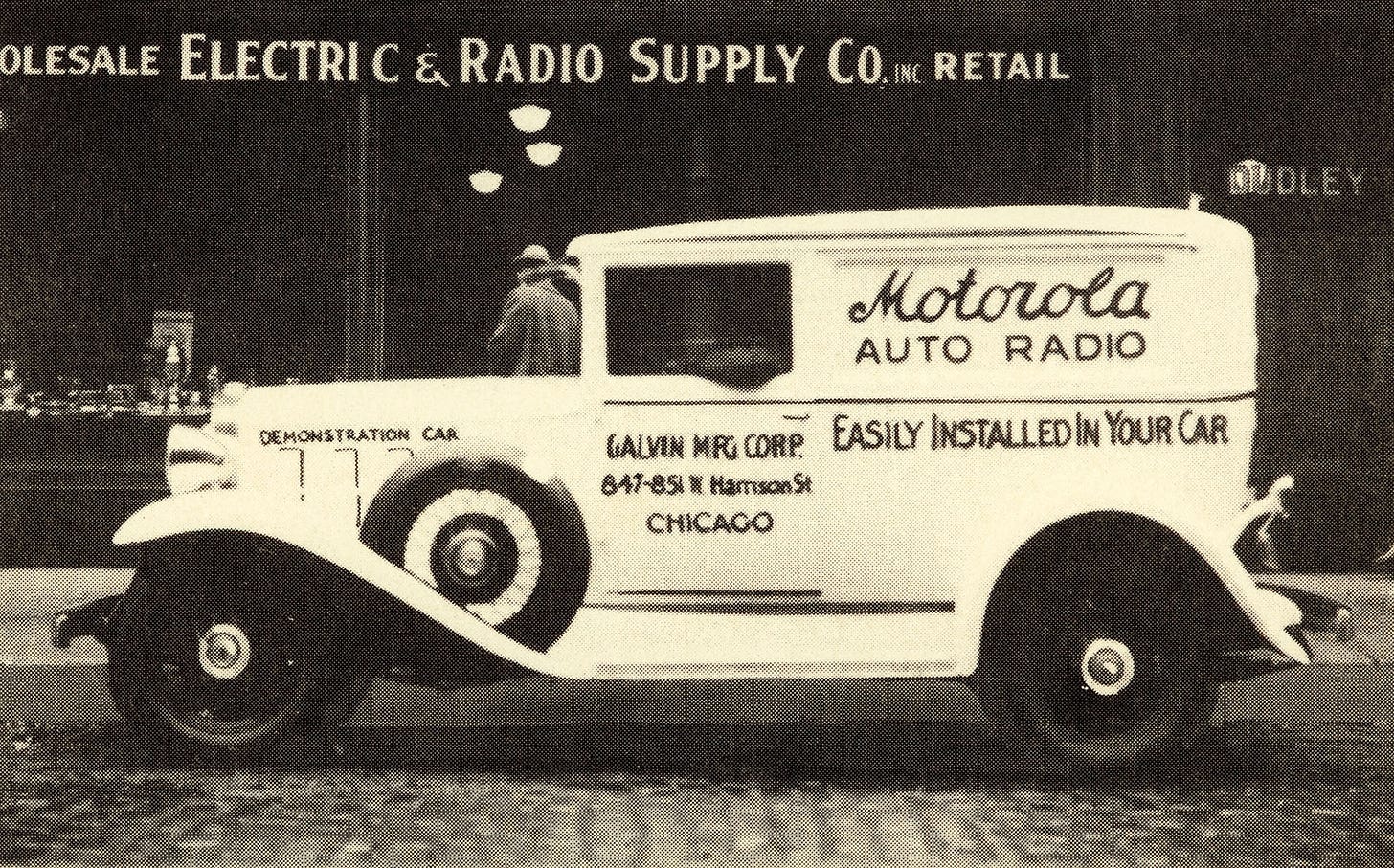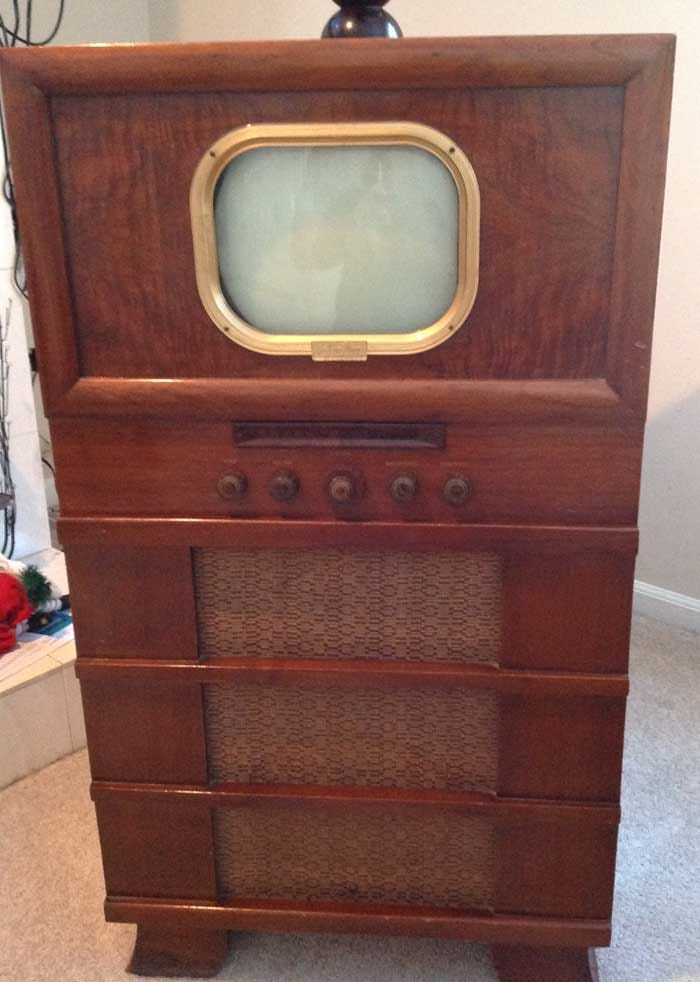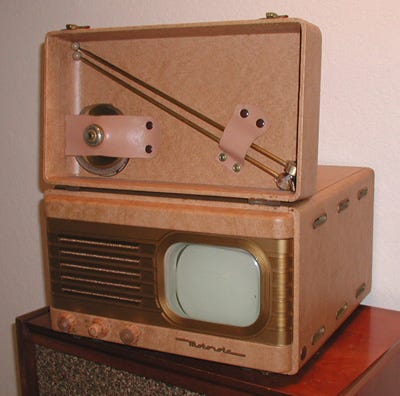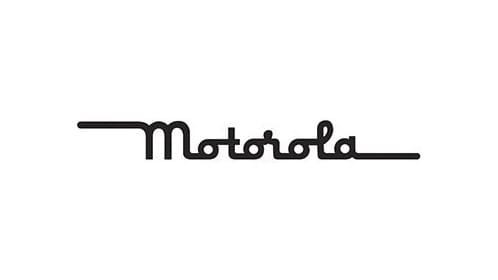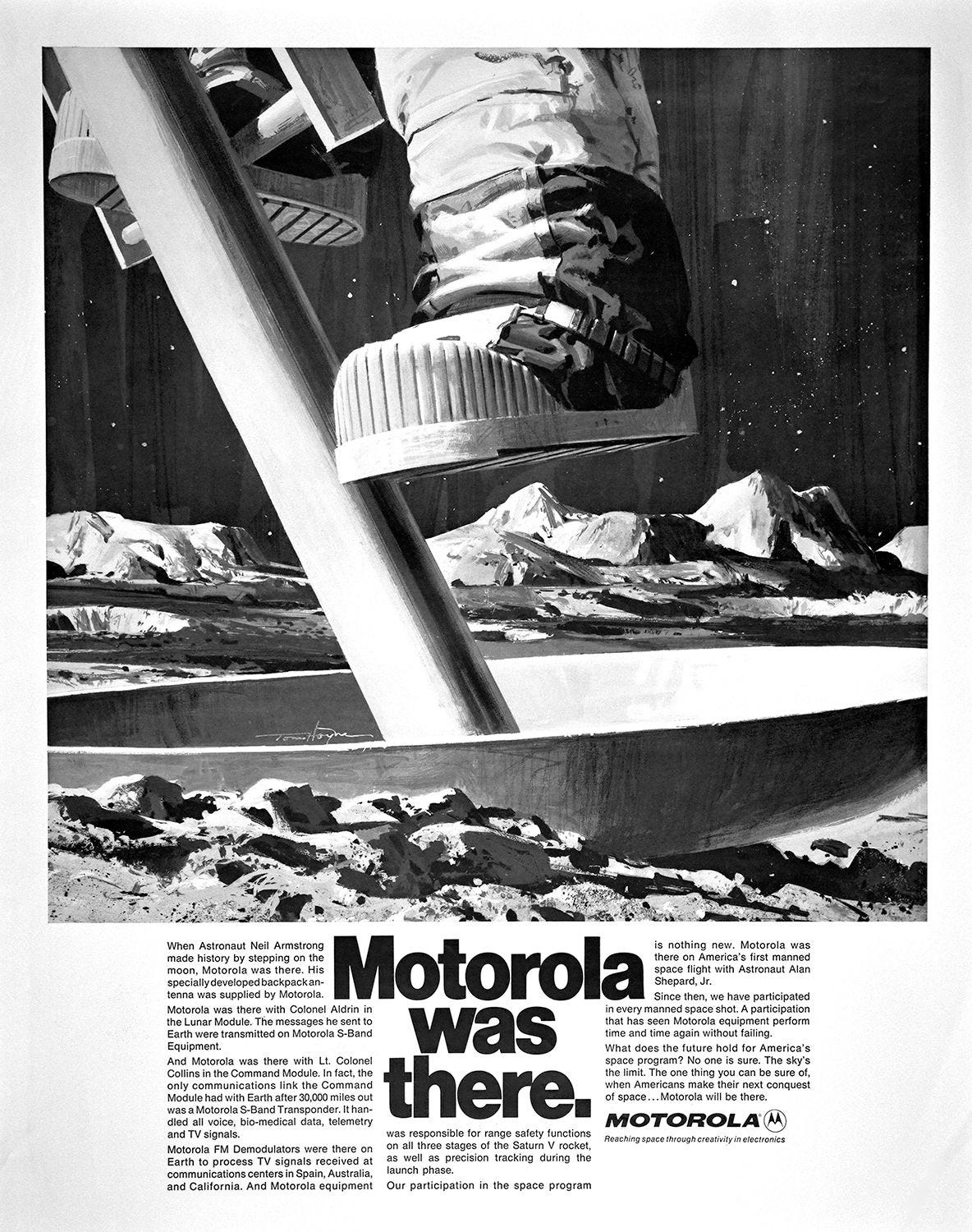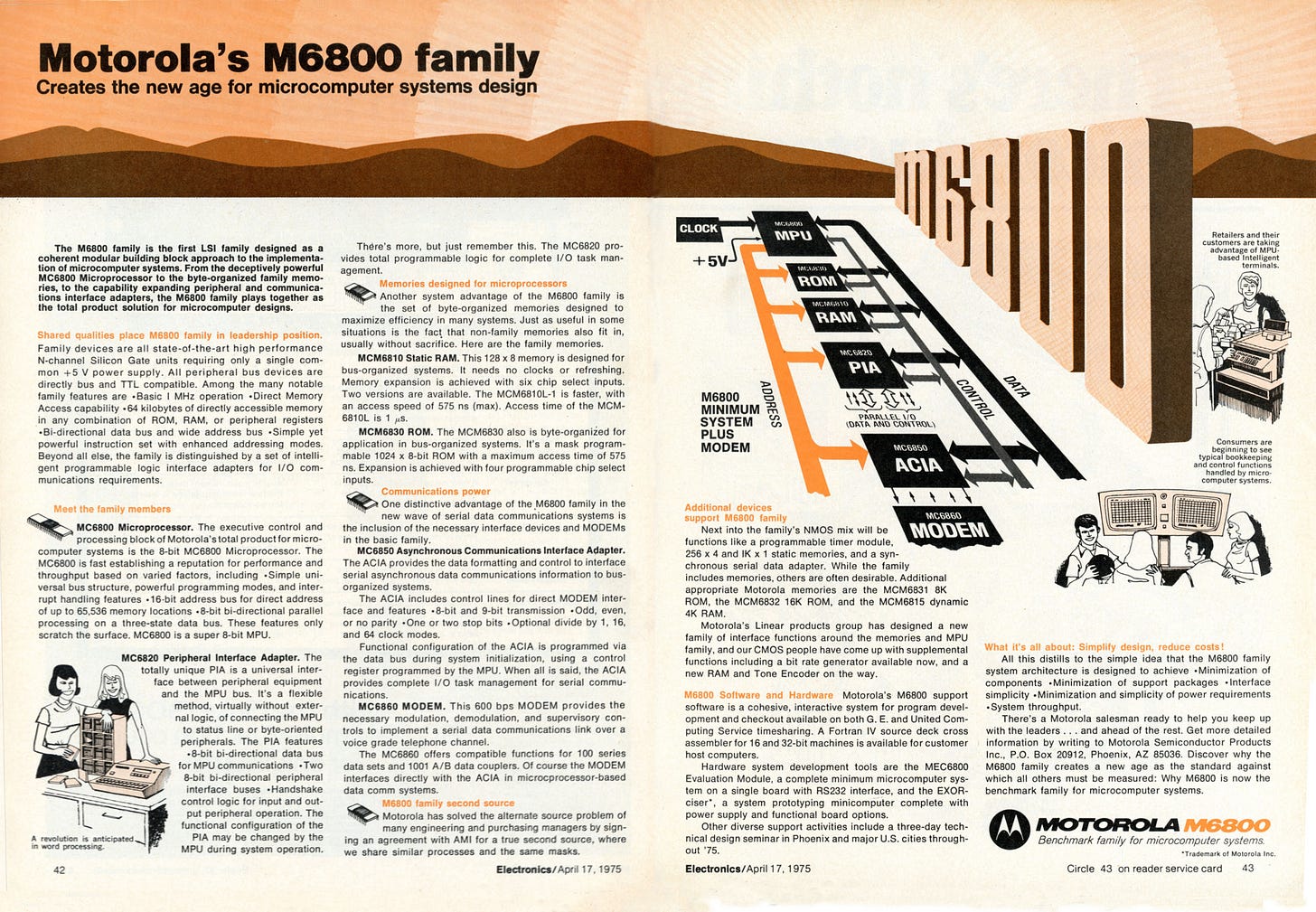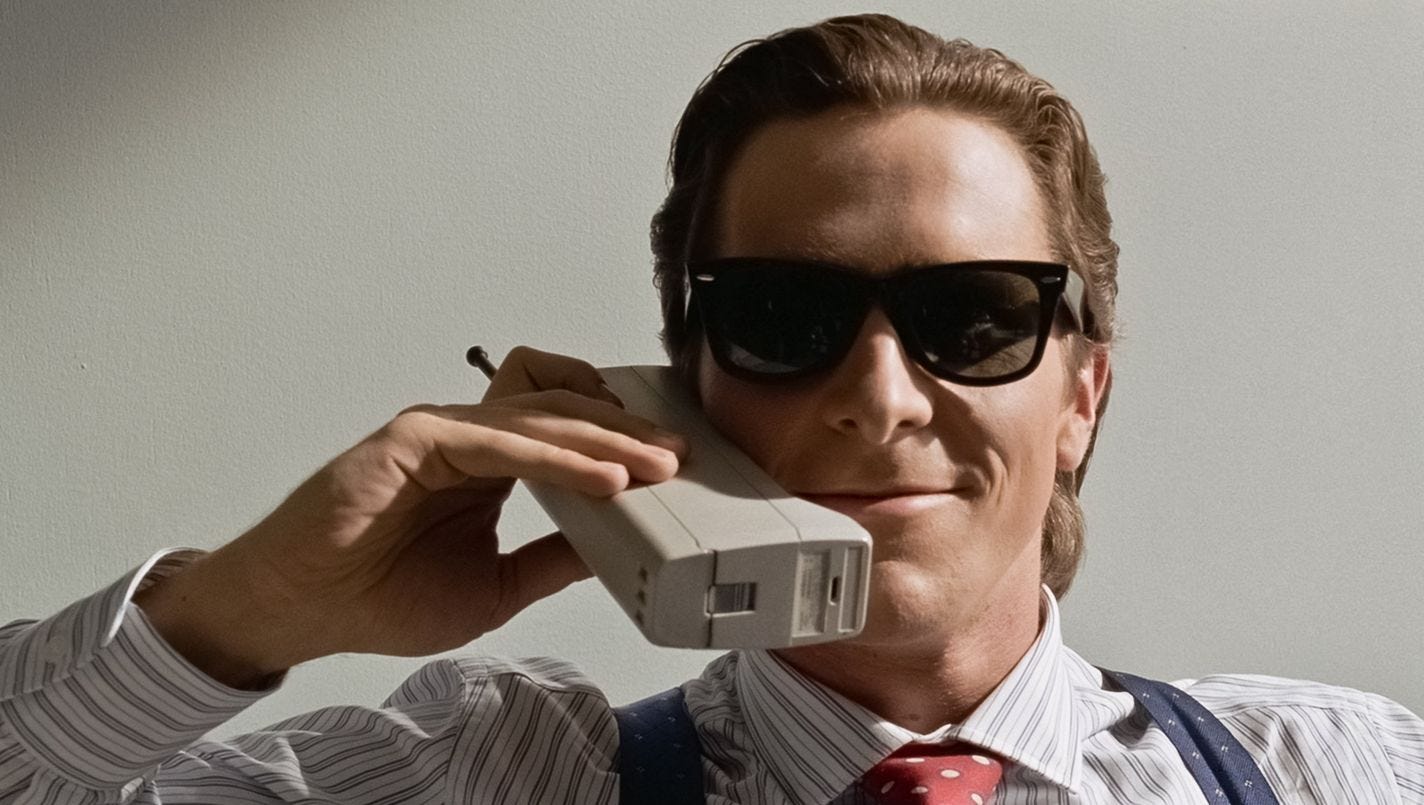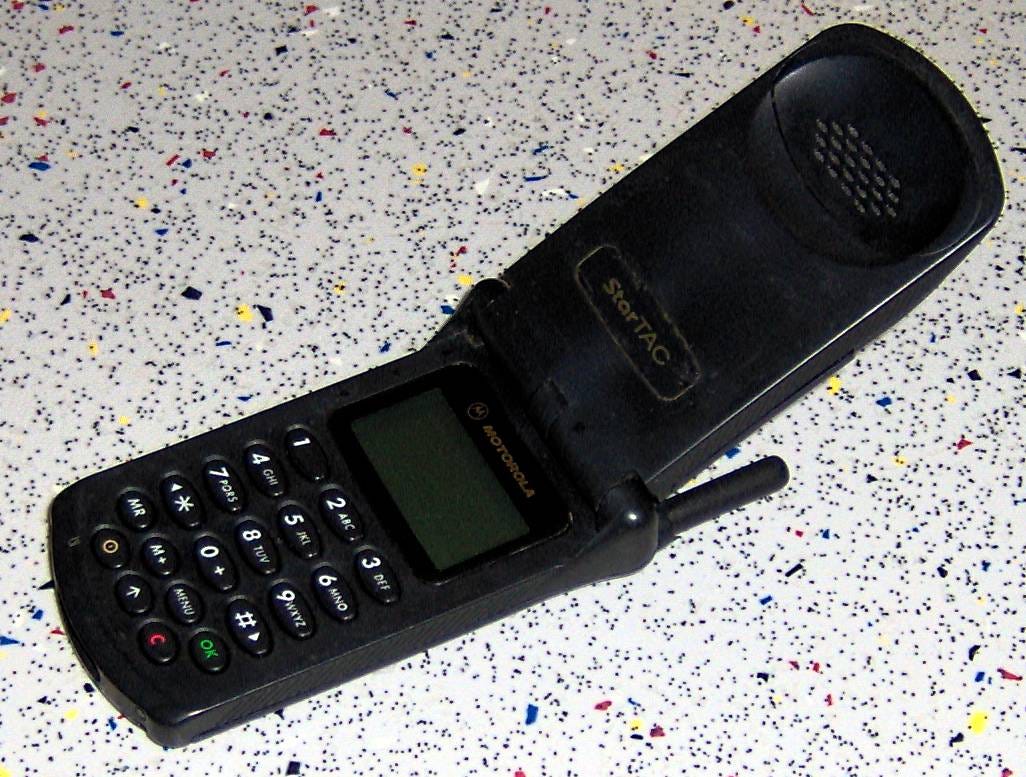The History of Motorola
Wireless mobility, CPUs, and an argument with Steve Jobs
Paul V. Galvin was born in Harvard, Illinois in June of 1895. Not being particularly wealthy, the young Galvin worked at a railroad roundhouse (a building for the storage and service of locomotives) with intention of saving for a university education. He was somewhat successful, and he was able to attend the University of Illinois for two years. At that point, he needed more money, so he went back to the roundhouse. With the outbreak of WWI, Galvin enrolled in officer training, got his commission, and served in France as an artillery officer. In 1919, home from the war, he and his friend Edward Stewart started a battery company. That company ended in 1923 on account of unpaid taxes. Galvin, now with a wife and a son, moved to Chicago.
Galvin and Stewart, ostensibly having learned from their first attempt, started a second company in 1926. Radios were the new hotness, but most of these were battery powered as they required direct current. The two saw a market opportunity in offering a “battery eliminator,” which was a rectifier (converts AC to DC) not unlike the switching power supplies for PCs. With this battery eliminator, a family could simply place their radio in their living room, forget about changing batteries, and listen to their favorite programs. This company went bankrupt, but Galvin knew the product was good. When the company went up for auction, he bought the battery eliminator for $750 and the rest was bought by Sears Roebuck and Co.
With the rectifier in his possession, Galvin and his brother Joseph founded the Galvin Manufacturing Corporation on the 25th of September in 1928 at 847 West Harrison Street in Chicago.
The company then began selling their battery eliminators to Sears who then sold the product to consumers. Of course, many of you will realize that starting a company in late 1928 was… unfortunate. With the on-set of the great depression, radios became luxury items and a diminution in battery eliminator sales followed.
Thing is, in the USA, a car isn’t exactly a luxury good. For most of the USA, if one expects to be employable, he/she must have a car. This presented another market opportunity to Galvin Manufacturing. To the eyes of Paul Galvin, each and every automobile sold in the USA was a potential sale of radio. At the time, this wasn’t simple. Radios weren’t small, and the electrical components already in any given car produced interference. The radio would also require more voltage than cars then were equipped to handle, 50 to 250 volts of direct current. Circumventing these problems, the radio receiver was fixed to the engine wall, wires were run to the controls and speakers mounted on the dash, a battery dedicated to supplying the radio was placed under the seats, and a rather long antenna was fixed on top of the roof along with a wire mesh to prevent interference.
In May of 1930, after several months of iterative development, Galvin’s engineers, Elmer Wavering and William Lear, installed a radio in his Studebaker. The company didn’t have much money for advertisement, so Galvin and his wife, Lillian, got in and drove from Chicago to Atlantic City, pulled up to the Radio Manufacturers Association Convention, parked at the entrance to pier, and turned up the volume. A crowd quickly gathered around the vehicle expressing quite a bit of excitement and enthusiasm. Over the next few days, any time the crowd shrank, Galvin would go inside the exhibit hall and wrangle more folks to come look. Lillian would then demonstrate the radio to those present. When the two departed Atlantic City for their drive back to Chicago, they did so with enough orders to fund the build out of manufacturing and installation capabilities. The new Motorola (a combination of motorcar and Victrola) sold for $130 which would be roughly $2,454 in 2024 dollars. Of the installation process, Wavering recalled:
If somebody bought a new car and decided to put in a car radio, they'd get a real shock. They saw us go in and rip out the brand new headlining in the car, drill holes into the floor for our batteries, and rig up a whole complicated electrical system with a network of wires.
Given the rather immediate success generated with the appearance in Atlantic City, Galvin and Wavering did a tour as travelling salesmen. With each sale, they’d also offer some training to dealers for installation. The success of this then encouraged the company to assemble a fleet of cars and an army of salesmen who’d been well trained on the installation process.
In November of 1930, Galvin MFG obtained contracts to outfit the municipal and law enforcement fleets with radios in River Forest, Bellwood, Evanston, and Cook County (all in Illinois), as well as the Illinois State Highway Police. This led to Motorola introducing a dedicated model for police and governmental use in 1936, the Motorola Police Cruiser Radio.
The company expanded its product offerings to home radios in 1937, to two way radios in 1939, and to handheld two-way radios in 1940. Up to this point, everything Motorola developed was AM. The company brought their first FM models to the market in 1941, and the world’s first portable two-way FM unit was introduced in 1943. This was the SCR300, and was worn in backpack. It weighed 35 pounds, had a range of about 20 miles in optimal conditions, was nicknamed the walkie-talkie, and it was developed for the Army Signal Corps.
Galvin Manufacturing went public in 1943 under extremely somber circumstances. Galvin was in need of money to cover inheritance taxes owed upon the murder of his wife Lillian by a home invader. Despite the company’s now public structure, it was still run as if it were a family owned company. Galvin’s son, Robert (Bob), had begun working in the mail room each summer while attending the University of Notre Dame, and he advanced through the company quickly. The younger Galvin graduated in 1944, and came to the company full time.
The company made its first mobile phone, the Car Radiotelephone, for the Illinois Bell Telephone Company. They also made the ground stations for these. The first phone call made from a Motorola car phone was on the 2nd of October in 1946 in Chicago. The company changed its name to Motorola Inc in 1947. It was also in 1947 that Motorola expanded its product offering to televisions. This began with the Motorola Golden View series model VK101 Consolette. It sold for around $400.
The next model was the VT71 table model, and it sold in higher numbers being far more affordable at $179.95. In just the first year on the market, more than 100,000 VT71 units were sold.
A variant of the VT71 television was offered as the VT73 with a leatherette covered case, meant to be portable, and it had rabbit ears stored in the front hinged cover.
With the push into televisions, the company introduced a new logo.
In 1949, two years after the discovery of the transistor at Bell, Motorola started a solid-state research and development laboratory in Phoenix under the direction of Daniel E. Noble. Noble had already been instrumental in the company’s FM successes, and he was serving as the company’s director of research by this time. Thanks to their own research, and all of the advancements at Bell by Bardeen, Brattain, and Shockley, Motorola’s Bill Taylor developed a high-power germanium transistor for car radios that could be mass produced and made commercially available. The initial 2N176 was rated at 6A, 15V, 4kHz, 90°C Tj max, and was most commonly used as a car radio amplifier. Over one million 2N176s had been manufactured by January of 1957, and while the initial price for this transistor was $26, that price had fallen to just $2 by 1960. Such was the foundation of the Motorola Semiconductor Products Division. The most enduring logo of Motorola had been introduced in June of 1955. It was designed by Morton Goldsholl, and it was printed on all these wonderfully packaged transistors coming out of Motorola.
While many people often say things like “no one could have foreseen x, y, or z,” such statements are almost always incorrect. Had people not foreseen various technologies, those technologies could never have been made. When Noble began working on the development of semiconductor manufacturing in Phoenix, he predicted that transistors and other semiconductor components would shrink the size, improve the reliability, and reduce the power consumption of the machinery into which they were installed. Beyond that, he predicted that they’d enable entirely new kinds of products in the fields of instrumentation, metering, controls, communications, and computing. He was absolutely correct, and the company for which he worked would be engaged in all of those new product categories.
Still in 1955, Motorola announced the Handie-Talkie Paging System providing pagers within hospitals, factories, and office buildings. For a company purchasing a paging system, Motorola provided the selector console, transmitter, and pocket receivers. These were made available in 1956.
In 1956, Bob Galvin began the process of taking over daily operations of Motorola as President, while his father remained as CEO. In 1958, the younger Galvin succeeded his father as CEO. Sales revenue for 1958 was $216.6 million which would be about $2.4 billion in 2024 dollars.
Motorola was quick to develop a relationship with NASA. On the 31st of January in 1958, the Explorer 1 satellite was launched into space from Cape Canaveral. The purpose of the mission was to measure the amount of radiation in orbit. The experiment designed by James Van Allen revealed that much less cosmic radiation was present than had previously been believed, and Van Allen then theorized this was due to saturation of the detector by charged particles trapped by Earth’s magnetic field. This theory was confirmed by Explorer 3 in March and further confirmation was provided by Explorer 4 in July (although this wasn’t the primary mission of Explorer 4). The belts of charged particles were then named the Van Allen Belts. These satellites carried two Motorola transmitters each. The first was 60mW and amplitude-modulated, the second was 10mW and phase-modulated. Both transmitted continuously at 108MHz (though data was only received when the satellite passed over one of the 17 receivers on Earth), and were battery powered. On Explorer 1, the 60mW transmitter operated until the 12th of February, and the 10mW transmitter operated until the 16th of March. This early success with aerospace radio telemetry aided Motorola in gaining later contracts, and it certainly didn’t hurt their marketing efforts.
By the 1960s, Motorola was selling in excess of 4,000 different electronic parts, and they were active in radio, television, and telephony. In 1965, the company worked with Ford and RCA to develop and manufacture 8-track players for automobiles. This was followed by the introduction of low-cost transistors packaged in plastic. The company released its first color television, the Quasar, in 1967.
On the 20th of July in 1969, s-band transponders both aboard Apollo 11’s lunar module and at the command center on the Earth transmitted telemetry, voice communications, biomedical data and television signals between Earth and the moon. Those transponders were made by Motorola. Naturally, Motorola wasn’t shy about their involvement.
For Motorola in 1970 and 1971, LSI was becoming a bigger and bigger potential revenue stream. The company was working on several different ICs at the time, and many requests for implementations of custom designs were coming in to the semiconductor products division. Many at the company were starting to see that what was really required was a more generic design that could be used by any given company to build any given product. With the scale of production Motorola could achieve, this would provide better unit economics than one-off designs at lower volumes. After a bit of a market survey, a small team (Tom Bennett, Jeff LaVell, Link Young, Mike Wiles, Gene Schriber, Doug Powell, Bill Mensch, Bill Lattin, and later Chuck Peddle, John Ekiss, and John Buchanan) realized that this MOS product would effectively need to be built in MOS and be a general purpose microprocessor not unlike the Intel 4004. They also knew that they’d need ROM, RAM, and a peripheral interface adapter. Due to the tight integration of these, they’d need to be designed together. Thing is, this kind of product would require a clean room, five volt power supplies that were really well made, and there was quite a bit of specialized equipment that would need to be made or purchased. While those things were being sorted resulting in a new manufacturing center in Austin, layout was starting in late 1972. The first working parts were made in February of 1974, but production at scale began in November. This was the Motorola 6800. It ran at 1MHz, had an 8bit data bus, 16bit address bus, and it shipped in a 40pin DIP. The CPU was constructed of 4100 transistors, and it could address up to 64KB of RAM. It required a two phase clock to operate (6870), and to be useful to any degree it would also require RAM (6810 or Intel 2114), a PIA (6820 or 6821), an asynchronous communications interface adapter for serial (6850), and an EPROM (2716). For the entire set of chips only a single 5 volt power supply was required. In order to gain significant contracts, it was common for CPU makers to license their designs to third parties to provide customers with a second source. The first of these for the 6800 was American Microsystems, but later Hitachi, Fujitsu, Fairchild, Rockwell, and Thomson gained licenses to manufacture the 6800 family of chips. Later iterations were made that combined many of these chips to reduce costs. The 6801 was launched in 1978, and it was something like an SoC combining CPU, RAM, ROM, timer, I/O chips into one. It had 2K ROM, 128 bytes of RAM, 31 parallel and programmable I/O lines, and the address and data buses were compatible with the 6800 allowing other support chips to be used with it. This was followed by the 6805 which dropped support for some less commonly used instructions and thereby further reduced costs. The 6809 added some new 16bit instructions, and the data bus was widened to 16bits. For these 16bit instructions two 8bit accumulators would be linked to form a single 16bit register. The 6809 was also faster than the original 6800 when executing 8bit instructions. However, the 6800 and the 6809 were not fully compatible with the 6809 having just 59 instructions compared to the 6800’s 78.
The Intel 8080 had entered production in April of 1974, and this somewhat hurt the 6800. Yet, according to Federico Faggin, the 6800 had the better design despite being “very large and very slow.” Faggin credits the the late launch of the 6800 and its relatively large size and slow speed for the 8080 gaining market acceptance. For all that, he still stated that the 6800 had better memory addressing and was a nicer machine. Yet, the 8080 wasn’t really the prime impediment to the 6800, it was the 6502. Chuck Peddle felt that Motorola should make a cheaper chip, and Motorola really didn’t like that idea. Peddle, Mensch, and several others defected to MOS, where they then created the 6502. Of course, Motorola may have been able to overcome new competition, but by July of 1974 it had become quite obvious that a recession was hitting the semiconductor industry, and it was hitting hard. Intel was hit too. The timing for the $25 MOS 6502 couldn’t have been better. By November, Motorola had laid off 4500 employees, and the Semiconductor Products Division had had a change in management. Yet, the 6800 did see some adoption even if it was a distant third to the 8080 and 6502 (and CPUs compatible with those two). Machines like the MITS Altair 680 were available by the end of 1975. The kit form of the Altair 680 sold for $293, and the assembled and tested version was $420. Sphere had a single board computer with the 6800 available for $350, and a more complete system available as a kit for $6100 or pre-assembled for $7995. Southwest Technical Products Corporation released the SWTPC 6800 kit in November of 1975 for $450. For the time, were one able to afford the SWTPC, it would have been a wonderful system. Control of the machine was fully enabled via serial, allowing a user to use a terminal or teletype and load software via paper tape. The SWTPC 6800 was also silent compared to its competitors with the top of the casing being a screen allowing excellent air flow with no fans. Along with these abilities, the SWTPC 6800 came with ROM, 2K of RAM, clock, bus buffers, RS232 interface board, the power supply, and an additional 2K of RAM was available for just $45. A terminal from SWTPC was an additional $275. With the Altair systems, adding the additional boards would have raised the total cost to more than $600. For reference, $600 in 1975 is roughly equivalent to $3,420 in 2024 dollars. The most famous machine to use an 8bit Motorola CPU was the TRS-80 Color Computer released in September of 1980, which used the 6809, up to 32K RAM, and ran MS Color BASIC.
Additionally, in 1974, Motorola sold its television business and the Quasar brand to Matsushita. I imagine that most of us today who remember Quasar televisions remember them only as Panasonic (which is Matsushita) products. For myself, it was one such Quasar television with which I used my 800XL built around a MOS 6502. The irony of that combination is just wonderful.
The Silicon Products Division began work on Motorola’s Advanced Computer System on Silicon, or MACSS, in 1976. But things were slow at first. In 1978, Motorola and Hitachi began exchanging some technologies, and in particular Motorola sent around 70 people to Hitachi’s fabs to see how they were building their semiconductor products. Bill Walker, the Transfer Manager for Motorola described this, “We took what we did best and combined it with what we learned from the Japanese and we became very good at manufacturing.” Once the manufacturing systems were brought up to modern standards and running well enough to supply GM with nearly $250 million in engine controllers each year, the team finally started to get serious about MACSS. They saw Intel as a serious competitor, and they didn’t count Zilog out of the race, and they felt they really needed to execute perfectly. Intel, ZIlog, and MOS had taken all of the low-end market, and in the case of MOS, Crook was determined to never allow a spin-off of Motorola’s own products eat their lunch. The team was managed by Colin Crook, and the design was led by Tom Gunter. The team was given the freedom to design this product without regard to prior chips, and a heavy focus was placed on being both powerful and easy on developers. Yet, right away, the developers realized that for a new chip to gain traction, it would need to be at least somewhat compatible with the previous era’s support chips (not unlike the choices Intel made with the 8088). So, while this new chip would be at least 16bit, it would need to support the 8bit support chips of the prior 6800 family. Not only would this decrease the cost of completed systems, it would greatly speed adoption. To take the performance crown, the chip would need to be 16bit or 32bit, and it would need to handle 32bit data and address well. Primarily, it needed to be quick with extended precision arithmetic. Unfortunately, packaging made a true 32bit chip unfeasible at this time. To get everything to work at a price that was feasible, the chip would have a 32bit ISA implemented in 16bit components, 32bit registers, and it would limit itself to a 64pin DIP with 16 data pins, and 24 address pins. To get the best performance out of the chip as was possible at the time, the team decided that it should be implemented in a single-channel NMOS. MACSS became the Motorola 68000 (or m68k) and was formally announced to the world in September of 1979 with the first samples making their way out in February of 1980, and mass production chips available in November. It was built of 68,000 transistors in 64-pin DIP and clocked at 4MHz, 6MHz, or 8MHz. Chips clocked at 10MHz were made available in 1981, and 12.5MHz parts were made available in 1982.
The m68k was well suited to use with UNIX and this quickly gained it a spot in early workstations. This became so common that the team at Motorola began referring to such customers as JAWS, or Just Another WorkStation. Examples of such machines are the Apollo/Domain systems, Sun workstations before SPARC, Sage II and Sage IV systems, the Micromega 32 from Thomson, HP 9000, the Corvus Concept, and the early SGI systems. Similar to Tandy shaking up their CPU choice with the CoCo, the TRS-80 Model 16 was shipped with the m68k, and this line later included the TRS-80 Model 16B and the Tandy 6000.
As Steve Jobs was working on the Macintosh, he approached Motorola about the m68k, but he only wanted to pay $15 per chip at a time when Motorola was selling the chips at $125 in volume orders. Gunter and Jobs went back and forth a bit, and at some point Gunter responded with a question, “Well, what are you willing to commit to?” Jobs responded, “We’ll use a million in a year.” Gunter then stated, “Steve, here's the deal; if you buy a million chips you will not pay more than 15 million dollars, today.” The result of these negotiations ended up being a staggered pricing system specifically for Apple. Pricing for bulk orders started at $55 per chip, then dropped to $35, and so on. In the end, the average price Apple paid was actually below $15. By the time Apple had bought their millionth 68000 family CPU, they were paying $14.75.
The Motorola 68000 was followed by the 68010 and 68012 in 1982. The 68010 was in the same package as the 68000 and was pin compatible. The 68012, on the other hand, was in an 84pin PGA. Both of these fixed some small flaws in the original chip, optimized a few circuits, added virtual memory support, and added features to support virtualization. In the case of the 68012, memory addressing was 31bits wide allowing up to 2GB. These chips were also user-mode compatible with the 68000, allowing forward compatibility of application software.
The Motorola 68020 was a true 32bit chip unlike its predecessors, and the 68020 was available only in a 169pin PGA package. The 68020 also moved away from NMOS to CMOS. The chip could be clocked from 12.5MHz to 33MHz, and it was built of 200,000 transistors. At its highest clock, the chip was capable of around ten million instructions per second. The 68020 was used in the Machintosh II and LC, the Amiga 1200, and many more machines. Yet, this chip’s success wasn’t a guarantee. The design was completed in the middle of 1983, and it was then announced in June of 1984. The chip didn’t become available for nearly another year, and large deliveries weren’t available until late 1985. This is largely due to the fab for the chip having near zero yield. This was solved by Bill Walker who’d been brought in from another location to solve the problem.
In 1984, Motorola changed the world. While today, some may lament this change, it was the culmination of over a decade of work by the company. The company had been researching cellular phone networks from 1972 onward. The company’s first demonstration of a working cellular telephone was made on the 3rd of April in 1973, and Motorola had finally received approval for the commercial release of the device from the FCC on the 21st of September in 1983. This was the DynaTAC 8000X, and for all of the technological feat that it was, it sucked. First, it was priced at $3995 or about $12,000 in 2024 dollars. Second, it weighed 2.5 pounds. Third, a user of the brick-like monster could expect about 30 minutes of use per 10 hour charging cycle.
While the 68000 and its descendants were in use in essentially everything that wasn’t an IBM compatible (Atari ST, Amiga, Macintosh, Sega Genesis, CD-i, NeXT, AT&T UNIX PC, Tandy workstation lines, Sun systems, SGI workstations, Sinclair QL, TI calculators, Palm Pilots, and more) this wouldn’t remain the case. The rise of RISC chips ultimately made it impossible for the 68000 series to remain competitive in the workstation market, and this ultimately meant that Motorola’s most well-known CPU wins are the Macintosh, the Atari ST, and the Commodore Amiga. The final 68000 series chip was the Motorola 68060 released in April 1994. It could be clocked from 50MHz to 150MHz, and was internally a RISC design. By the time the 68060 was released, however, the line was moribund. The AIM Alliance (Apple, IBM, Motorola) had begun working on PowerPC as a common platform on the 2nd of October in 1991. This also ended the briefly lived Motorola 88000, which was a true RISC chip with a RISC ISA. The 88000 was late to market, but it did see some use in UNIX workstations before its life was cut short.
Motorola’s quality at this time (early to mid 1980s) was quite high, partially due to the company’s Six Sigma manufacturing process, and partially due to the company’s rather good culture that placed respect for employee’s at the top of its value list. For the average employee, after being hired, he/she could expect gainful employment until retirement. Employees would also see promotions every few years, annual bonuses based upon the company’s profits, good benefits (even in retirement), and educational opportunities. After ten years, employees who’d had a good record with the company were considered “Galvinized.” Essentially, these employees couldn’t be laid off or fired without Bob Galvin himself saying so. This allowed these employees to take a bit more risk in the market, be more innovative, and generally feel that the company would support them every bit as much as they supported the company. This level of employee protection also meant that employees could challenge policies and processes when things weren’t working. This went all the way to the top of the company where executives would argue things out rather openly. Those at the top weren’t necessarily the wisest, and the company rather expected that anything could be challenged. Open discussion was strongly encouraged, and one’s time and loyalty were richly rewarded at Motorola.
Rather importantly for the world today, Bob Galvin and the rest of Motorola struggled to penetrate the Japanese market much at all. This kept them from both being able to sell in Japan and being able to produce in Japan to any meaningful degree. As an alternative, Galvin looked to China. Motorola was eventually permitted to manufacture in China on the condition that Motorola educate its employees and suppliers in the country on manufacturing processes that would be competitive globally. Essentially, China told Motorola, sure you can set up shop as long as you enable us to compete with you. Galvin was smart enough to realize that China’s size made that worthwhile, even a small slice of that market could potentially beat North America’s sales figures. Motorola then took its best technologies and built factories in China, and the knowledge of how to make high-end electronics products proliferated throughout the country. This was, really, the last thing that Galvin did as CEO. He retired from that position in 1986, but he remained Chairman of the Board. William Weisz became CEO after Galvin. By this time, Motorola’s sales had grown from $216 million in 1958 to $6.7 billion by the close of 1986.
In 1986, perhaps realizing that DynaTAC was a bit early, Motorola released the Bravo pager. Unlike the company’s earlier pagers, the Bravo made use of the cellular network. The Bravo was a hit. It sold millions all over the globe. It had a single line, 12-digit, numeric display with a backlight. It held 6 messages, and it would detect duplicates to avoid wasting memory. Alerts for new messages could be auditory or vibratory, and the device had a low battery alert as well. In 1988, the Bravo pager factory in Boynton Beach, Florida became fully automated with 27 robots overseen by 12 humans. A pager could be made from start to finish in two hours, and this dramatically reduced costs.
On the 25th of April in 1989, Motorola released the MicroTAC 9800X flip phone, a first for the industry. It was lighter and much smaller than the DynaTAC, and it was the first cellular telephone that could fit in a pocket. Depending up on the model ordered, the phone had either a 30 minute talk time per charge or 75 minute. Pricing at launch was $2995. At the time of the phone’s introduction, the USA had around 2 million cell service subscribers with almost half of those having been added just in 1988. That number would double the following year. The average monthly bill for those customers was around $98, which would be around $262 in 2024 dollars. As the company’s semiconductor products began rapidly losing their niche in the market, mobile technologies became a larger and larger share of revenue.
Whether it was due to Galvin no longer leading the company or due simply to the sudden riches of the mobile division, the company’s culture began to change, and it entered its warring tribes period. Internal company competition was encouraged, and the managers of different company divisions ran things differently from one another. So, for example, the mobile network technology group and the handset technology group worked independently of one another. The handsets wouldn’t necessarily work with the network technologies Motorola itself had developed. When the network technology group was well ahead on GSM technologies, the handset group was still selling analog units. This led to a rather unfortunate situation where the company’s own network engineers were all using Qualcomm phones rather than Motorolas. Apparently, the screaming matches between division leaders were intense. George Fisher took over as CEO in 1988, and this situation didn’t change. Motorola was still doing well enough that things didn’t necessarily have to change, and therefore simply didn’t. By 1994, Motorola held nearly two thirds of the cellular phone market. Motorola had $22 billion in revenue, $2 billion in profit, and mobile phones were responsible for 65% of that.
The AIM alliance was seemingly working, and Motorola released the StarMax in September of 1996. These used PowerPC 603e or 604e CPUs for the 3000, 4000, and 5000 series. The top of the line Pro 6000 machines (which were never released) used the G3. This last machine ran at 233MHz, had 32MB of RAM, 2GB HDD, Zip100 on IDE, and an ATI Rage II+ GPU. This machine used the Cobra logic board which provided PS/2 ports and SVGA from the PC world alongside typical Macintosh ports. The machines weren’t great sellers, but the full impact of their existence was far more than just low sales volume. Motorola COO Christopher Galvin (Bob Galvin’s son) and Steve Jobs got into quite a heated argument, and they couldn’t reach terms for continued licensing. All StarMax machines were pulled from the market before the end of 1997, which cost Motorola a loss of nearly $100 million on the StarMax project. Motorola then retaliated by downgrading Apple’s status to that of any other chip customer. The final retaliation from Apple was to work with IBM to remove Motorola from the AIM alliance. Motorola’s position was eventually reinstated in 1998, but the company sold-off half of its semiconductor business in 1999 which became ON Semiconductor. The other half became Freescale in 2004.
Chris Galvin had risen through the company and was made CEO in 1997. At this point, the company had more than 60 different business units, it was spread all over the globe, and its future wasn’t looking great.
Two things happened at around the same time: Motorola’s Iridium, and Nokia.
Iridium was Motorola’s answer to the issue of spotty networks. What happens when you’re outside of cellular service areas and you need to make a call? Their answer was a constellation of 66 satellites in low-Earth orbit and a phone that weighed about a pound and cost $3000, for which a minute of talk-time cost $7. Due the cost of the handset and network time, there was no demand. The operator, Iridium Communications, declared bankruptcy less than a year after starting and Motorola lost something around $2.6 billion. The first call on Iridium was made in 1998.
As for that other thing that happened, Nokia’s handsets were cheaper, supported all of the modern digital networks, and they were almost completely indestructible. If you dropped one on your hardwood floor, you worried more about the floor. The response to Nokia’s explosion into the market was the Motorola StarTAC. It first launched on AMPS networks, but cdmaOne, TDMA, and GSM models followed. At first, it did quite well, and over the phone’s life it would sell about 60 million units. Unfortunately, this wasn’t enough. By the end of 1998, Nokia was the leading mobile phone brand globally.
In the middle of 1998, Galvin began a turn-around program. First, he started consolidating factories. Then, he began eliminating or selling under-performing business units, and he cut almost 56,000 personnel. For 1998, this would result in the company posting a loss of $962 million. But this also meant that 1999 was looking up. The company was returning to profitability with revenues topping $30 billion. With the company’s cash cow having been and continuing to be mobile phones, Galvin began focusing on a new market leading handset.
Then, the Dot Com Crash happened. Motorola took a pretty big hit from 2000 to 2001, and the first major SARS outbreak in 2002 disrupted the company’s supply chains. In 2001, the company’s revenues fell by $8 billion resulting in losses close to $4 billion. This led to two board members visiting Galvin in his office in September of 2003. Galvin was fired despite the company still posting profit for the year, and Ed Zander was his replacement. Shortly after, the Galvin family began selling their stake of around $720 million.
The following year, Galvin’s plan, the Motorola Razr was released, and it led the company up 41% in sales, up 454% in operating earnings, and brought $1.8 billion in net cash to the balance sheet within the first half of 2004. The Razr was the best selling phone in the USA from the time of introduction until November of 2008.
While the sales of the Razr were amazing, they did slow over time, and margins thinned due to competition. Motorola lost its business in China in 2007. Chinese telecoms had upgraded their networks to 3G and Motorola was still pushing older 2G phones and usually at a significant discount. Samsung then took that market. The loss of China’s market in 2007, the economic crisis in 2008, and the market domination of the iPhone 3G which sold a million units in its first weekend, were too much for the company to handle. The company split largely due to the influence of a single share holder, Carl Icahn, who’d recently grown his holding to around 6 or 7 percent. Motorola Mobility was formed from the cell phone and cable television equipment business. Motorola Solutions was created from the enterprise equipment business and the associated corporate and governmental contracts. Motorola Mobility was bought by Google on the 22nd of May in 2012. The cable networking business was sold to Arris Group in December of 2012. The rest was sold to Lenovo on the 30th of October in 2014. Meanwhile, Motorola solutions continues to offer two-way radios for first-responders and law enforcement, software for law enforcement and military command centers including mapping and drone surveillance, body cameras, and ruggedized push-to-talk LTE handhelds running Android.
Motorola’s rich history lives on today in many ways. Every time someone listens to music in car, makes a call from a cellular phone, or even uses a switching power supply, some of the Motorola magic is there. Parts of the company itself live on in other companies, but much more of Motorola lives on through the memories people hold of some of their best products. For me, memories of the company’s pagers, Quasar TVs, and computers built around the 68000 (and the 6502 spin-off of the 6800) are priceless. Many thanks to the Galvin family for their contributions to our world.
I have readers from many of the companies whose history I cover, and many of you were present for time periods I cover. A few of you are mentioned by name in my articles. All corrections to the record are welcome; feel free to leave a comment.


